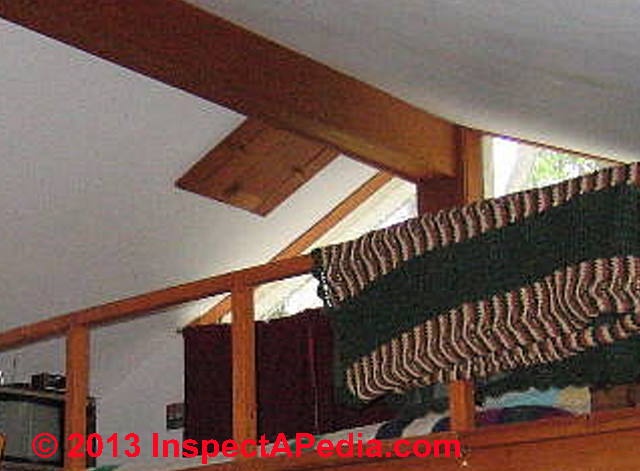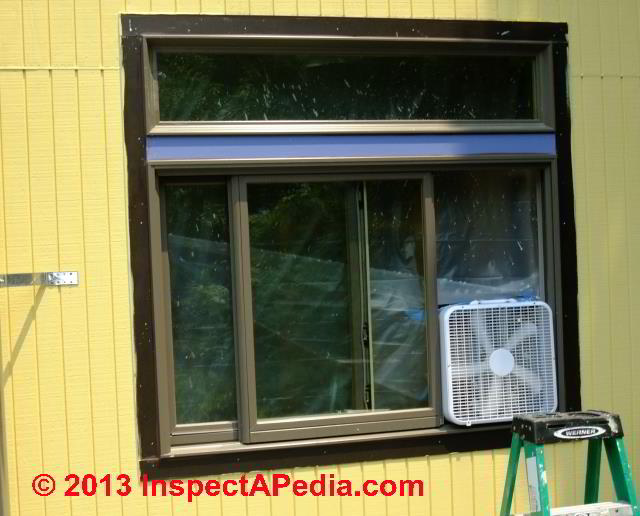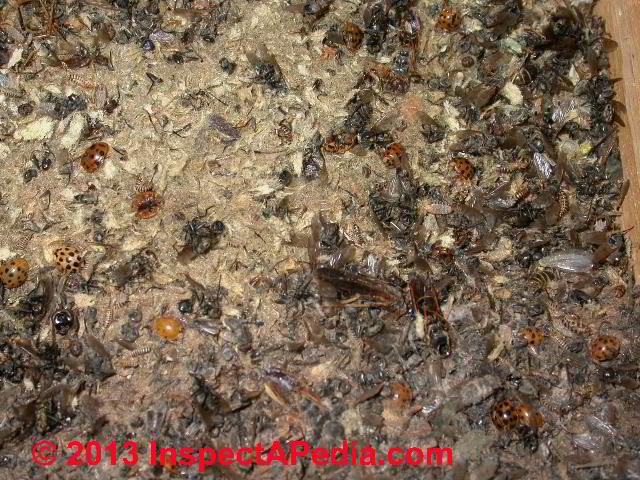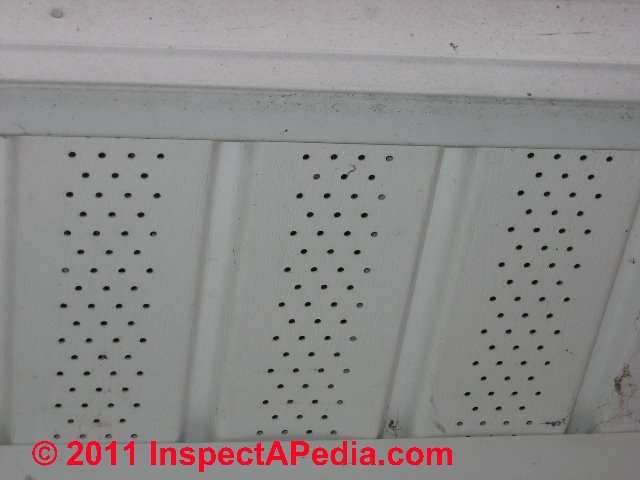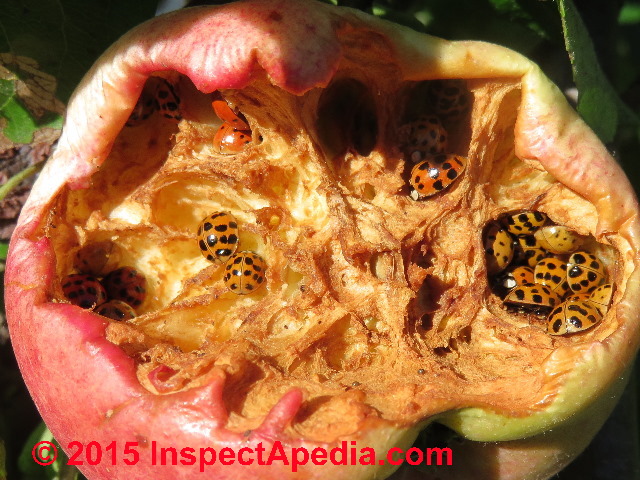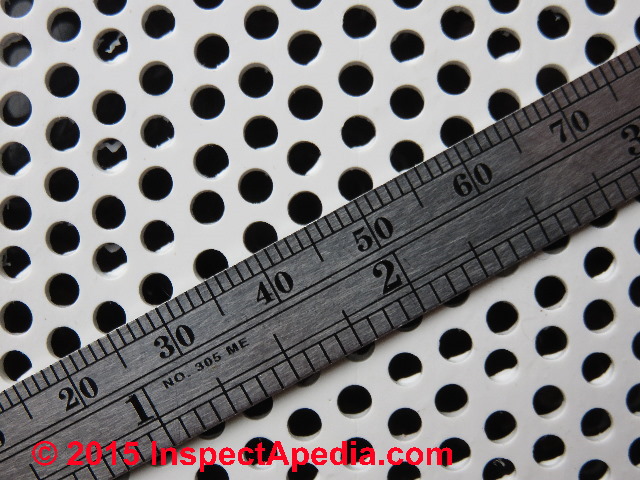 Flies, Mosquitoes & Flying Insect Removal from Buildings
Flies, Mosquitoes & Flying Insect Removal from Buildings
Suggestions for getting rid of pesky flies,
mosquitoes or most other flying insects
in & around buildings
- POST a QUESTION or COMMENT about how to get rid of flying insect problems in homes, outhouses & other buildings
Flies & flying insect pests in buildings:
Here we include fly control remedies from expert sources as well as from inventors & readers.
Some of these steps to get rid of flying insects indoors work for just about any species of flying insect that is attracted to light, odors, bug traps while others focus on specific insects (flies, mosquitoes, ladybugs).
We include research on the fly problem at & around buildings, both residential & farm buildings.
InspectAPedia tolerates no conflicts of interest. We have no relationship with advertisers, products, or services discussed at this website.
- Daniel Friedman, Publisher/Editor/Author - See WHO ARE WE?
Fly control in & around buildings; flying insect control & removal in buildings, outhouses, out-buildings, farm buildings
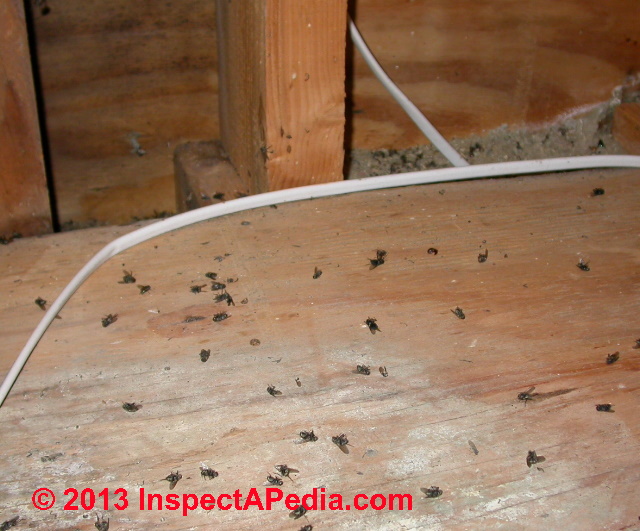 Categories of fly control in & around buildings
Categories of fly control in & around buildings
Control of flies & insects includes these subtopics:[1]
- Removal: usually refers to use of insecticides, sprays, fogs, traps, baits, to kill insect pests such as flies & mosquitoes
- Sanitation: keeping the building clean (good sanitation) to remove fly-breeding areas or removing standing water for mosquitoes
- Treatment: refers to use of residual sprays or insecticides on surfaces & materials that breed flies, such as manure piles
Photo at left: cluster flies in an attic wall and on the attic floor in a Pelham, NY home.
[Click to enlarge any image]
Insecticides used for fly control are typically described in these categories:
- Fly & other insect baits & traps
A bait or trap for flies typically combines an attractant and an insecticide. Baits & traps for some insects such as mosquitoes may include only an attractant (think roach motel, Japanese beetle pheromone traps, or the Hotel California - you can check in any time you want, but you can never leave). - Fly & other insect insecticides
- Fogs
- Sprays, including residual sprays
- See Hall & Jones (1993) for insecticide recommendations that are appropriate for some farm buildings
Watch out: selection and application of any pesticide, spray, bait, and even some insect traps should be performed by an expert, trained & licensed where requested. Misapplication of pesticides, insecticides, sprays, fogs, traps, baits may be unsafe and can present serious health risks for humans or other animals in and around buildings.
Question: How to Deal With too many Flies at the Outhouse or Latrine
My outhouse is producing a lot of flies inside this summer and i was wondering why and how to get rid of them. It has been a dry summer in Ontario and i thought maybe the pit was producing more flies because of the dryness.what should i do? - Devon 9/2/12
Reply: suggestions for fly control at outhouses, latrines, privies
- Make sure that the toilet lid is kept down
- Wash the urinal if there is a separate urinal device
- Make sure that your outhouse pit is properly vented above the roof
- Some folks hang flypaper inside the outhouse pit to reduce the fly problem further
- If your outhouse has electricity for lighting, whether solar powered or on the grid, consider our fly ejector fan and light design discussed in this article.
- At OUTHOUSES & LATRINES we describe & give the formula for sprinkling a small amount of lime in the outhouse or privy. The lime assists in crust formation on the sewage in the outhouse pit. The outhouse or latrine pit crust in turn helps reduce both the number of flies and the odor in the outhouse.
- At LATRINE TYPES & CONSTRUCTION we cite the U.S. army field manual on fly control at outhouses & latrines:
To prevent fly breeding and to reduce odors, the latrine box must be kept clean, the lids closed, and all cracks sealed. If a fly problem exists, they may be controlled by the application of a residual pesticide. Control effects should be based upon fly surveys and pesticides applied in accordance with label directions.
Pit contents should not be sprayed routinely since flies can develop resistance to pesticides if used over and over. The latrine boxes and seats are scrubbed daily with soap and water. Using lime in the pit or burning out the pit contents is not effective for fly or odor control; therefore, these methods are not recommended.
When a latrine or outhouse is no longer in use it must be closed as prescribed in the article we cited just above.
Fly Removal Suggestion: Electric Fly Ejector Gets Flying Bugs out of Buildings
How to combine a vent fan and a simple light bulb to blow flies, moths, mosquitoes or other flying insects out of a building.
Cervenka & Hahn (2008) and other expert sources confirm that flies are drawn to light and recommend that approach to attracting them to an area for removal by vacuuming. We took this idea further with a fly ejector mechanism that has worked well where there is a sudden and aggravating surge of indoor flying insects.
If your building already has a through-wall kitchen exhaust fan or a cathedral ceiling - roof exhaust or vent fan (below left), try clipping an incandescent light bulb as close as you can get to the center of the exhaust fan opening (we found that a 60 Watt bulb right at the edge of the fan opening worked wonderfully - Ed.).
In this photo, that brown wood rectangle is a removable hatch that gives direct access to a roof ventilation fan. Simply remove the hatch cover, clip a light to a hatch turnbuckle or to the hatch opening trim and turn on the fan to blow irritating flies & moths outside.
At below left we show a solar-operated roof exhaust fan that could be used also as a bug or fly ejector. A whole house exhaust fan can also blow indoor bugs outside, but is a bit dramatic and may not be something you want to run in all weather conditions & temperatures.
With other lights in the building area off and the exhaust fan running, turn on the light bulb next to the exhaust fan opening. You'll find (as we did) that most flying insects are attracted to the light and are promptly sucked (or blown) outside.
Larger insects such as moths and house flies produce a satisfying ping sound as they bounce off of the outdoor exhaust fan cover. - Editor.
Temporarily, even a box fan in a window along with a light bulb can produce quick and wonderful results (below).
Fly Killing Without Sprays or Pesticides
If a household or business has a problem with flies, try suspending a light bulb, preferably incandescent, over a pan of soapy water and leaving only that light on at night. In my experience, the pan will have collected the flies by morning. - E.B. [reader] 11/29/2013. Dr. E.B. is a physicist interested in, among other things, fly control in buildings.
Cluster Flies in Buildings
Cluster flies are a nuisance in buildings that can be prevented by sealing their points of entry into buildings. But in our experience such sealing is especially difficult on many older homes and in attics with various ventilation openings in soffits, eaves, and at ridges. Experts recommend vacuuming up cluster flies, attracting them with a light to make clean-up easier.
Photo at left [click to enlarge]: cluster flies, ladybugs and wasps all contend for interment space on the attic floor of this home in the northeastern U.S.
Use of an indoor spray insecticide labeled for indoor flying insects is acceptable, though we warn that some people such as those with allergies or asthma can be troubled by the common indoor insecticide ingredient of pyrethrins.
Significantly, Cervenka & Hahn point out that use of insecticide on cluster flies on a building exterior is rather irrelevant: when you see them alive they are trying to move away from the building, and treatment does not reduce the next fall's fly population.
Cluster flies (Pollenia rudis) are named for their habit of overwintering in large clusters within the attics or upper walls of homes and buildings. They are black and a little larger than house flies, from 3/8- to 1/2-inch long, with short, yellow hairs on the thorax. Their wings overlap when at rest.
Cluster flies are unique because they are parasites of earthworms. In summer they lay eggs in cracks in the soil, and maggots enter earthworm hosts through the body wall. There are two or three generations of flies produced each year. In August and September, the final generation of flies seeks shelter for the winter in homes and buildings.
Piles of dead cluster flies are often discovered in late spring when returning to northern vacation homes unoccupied during months when the flies emerge.
... Control of [cluster] flies seen in spring on the building exterior is not necessary because they are trying to move away from the structure. Killing these flies has little, if any, influence on the number of flies seen inside homes. Treatment in spring also will not reduce fly populations next fall. - Cervenka & Hahn (2008)
How to Keep Lady Bugs - Asian Lady Beetles & Cluster Flies out of Residential Buildings
Above is a typical perforated vinyl soffit covering panel through which one reader reports insect pests are entering: it's possible they are actually finding a different entry point than through those round perforations.
Above are Asian lady beetles (ladybugs or Harmonia axyridis) snuggled away in an apple picked by the author [DF] in Two Harbors, MN in the fall of 2015.
[Click to enlarge any image]
Reader Question: need small perforation soffit vent coverings or screens to keep out Asian Lady Beetles & Cluster Flies
7 Nov 2015 Anonymous said:
The recommendations for continuous louver-style aluminum soffit vents and the "older, uglier aluminum ridge vents" ignores the real problem of insect entry.
I have observed easy movement through these vents of Asian lady beetles and cluster flies prevalent in my area. I am now faced with retrofitting or replacing these vents with ones using finer mesh screening, but there are no commercially available ones that I can find.
I share your negative view of the "popular plastic mesh type ridge vent" because it allows much more limited air flow, especially if the installer mashes it down flat, as I have sometimes seen. Do you have any specific suggestions for vents that allow air flow but keep these invasive insects out?
This question appeared originally
at ROOF VENTILATION FAQs as part of a discussion beginning
at ROOF VENT SOFFIT + RIDGE NEEDED.
Reply:
Thanks for that interesting feedback: I've not heard of nor come across insect invasion through the soffit vent openings myself but I don't argue with first-hand experience.
The perforated soffit panels I've seen have openings just a few mm across and may be small enough to keep your lady beetles and flies out. But experts (cited) say that “Gaps of 1/8" or less will permit entry of lady beetles and other insects.”
As you can see in the photo just above, the size of typical round perforation openings in a modern vinyl soffit vent strip or vent covering is 3mm or a bit under 1/8". Tiny insects can, if they have reason to do so, enter a building soffit or attic through these openings, while larger insects such as flies or wasps will be kept out.
Some older soffit vent covering panels such as aluminum units whose openings were made by stamping small rectangular slot-type perforations have openings that are still larger.
As you are considering installing different soffit vent coverings I’d suggest a simpler approach: remove enough panels to lay flat copper screening material inside the soffits to keep the Ladies and cluster flies out of the soffits.
If you hold down the screening mechanically or with caulk at its edges or simply by laying a few furring strips on its upper surface that ought to keep bugs out. You’re also reducing the air intake flow rate so be sure your soffit panels are continuous rather than intermittent.
These insects (both ladybugs and cluster flies) are not considered harmful to humans (with a possible modest exception by Yarbrough 1999) but both are ranked as a nuisance pest, and both of these insects can leave a stain on surfaces if you try to sweep up their bodies.
That's why vacuuming them up is a better cleanup method. None of the sources we reviewed preferred use of insecticides to mechanical exclusion of insects and all included warnings about both the limited durability of insect sprays as barriers as well as warnings that misapplication of pesticides (such as spraying into a wall cavity) may be unsafe for the building occupants.
Details:
Size of Ladybugs - Asian Lady Beetles - and Cluster Flies
Asian Lady Beetles ( Harmonia axyridis (Pallas) what many call "lady bugs") are about 4 x 7 mm in size. (about 1/4" in length). They are harmless to humans but can create a bit of a mess inside. Best advice is to vacuum up the dead insects and keep them out of the building by sealing cracks and openings through which they enter.
Cluster flies (Pollenia rudis), also commonly called "attic flies" as adults are a bit larger, measuring 8-10 mm in length. I'm surprised that you are finding them entering through your perforated soffit intake vent openings.
How to Keep Asian Lady Beetles & Cluster Flies Out of Soffit Vents: caulk, seal or screen openings
The experts at every source we reviewed recommend as first choice that you keep these insects out of your building by "mechanical exclusion" - that means screening or sealing small openings through which they are entering.
None of the sources mentioned these insects entering through typical (modern) vinyl or aluminum soffit vent covering panel perforations (though it might be possible) and all of them point to entry points at cracks and gaps around windows, siding, utility pipes or wires, and underneath fascia boards or at window openings.
For both of these insects, before replacing soffit coverings themselves, I'd be sure to check to see if they are actually entering elsewhere - at a spot that is easier to seal off than it will be to take on the task of replacing or screening all of your soffit vents.
Seal the ladybug entry openings as well as cluster fly openings or gaps in late spring or summer - before these Asian Lady Beetles or cluster flies begin their hunt for a winter home. Both of these insects start looking for a passage into buildings in the fall. Close large openings with screening and small openings with caulk or exterior-rated foam.
U. Kentucky department of entomology has a nice article on Asian Lady Beetles and what attracts these harmless insects to buildings - cited just below.
Excerpting:
… Asian lady beetles are attracted to illuminated surfaces. They tend to congregate on the sunnier, southwest sides of buildings illuminated by afternoon sun. Homes or buildings shaded from afternoon sun are less likely to attract beetles. House color or type of construction (concrete, brick, wood/vinyl siding) is less of a factor for attraction than surface contrast.
Contrasting light-dark features tend to attract the beetles -- dark shutters on a light background, light shutters on a dark background, windows edged with light-colored trim, gutters and downspouts on contrasting siding, etc. Once the beetles alight on buildings, they seek out crevices and protected places to spend the winter. - U.K. Entomology website, retrieved 7 Nov 2015, original source: www2.ca.uky.edu/entomology/entfacts/ef416.asp
Research Citations on Asian Lady Beetle Infestation & Control at Buildings
- Colunga-Garcia, Manuel, and Stuart H. Gage. "Arrival, establishment, and habitat use of the multicolored Asian lady beetle (Coleoptera: Coccinellidae) in a Michigan landscape." Environmental Entomology 27, no. 6 (1998): 1574-1580.
- Koch, R. L. "The multicolored Asian lady beetle, Harmonia axyridis: a review of its biology, uses in biological control, and non-target impacts." Journal of insect Science 3, no. 1 (2003): 32.
- Potter, Michael F., Ric Bessin, Lee Townsend, "Asian Lady Beetle Infestation of Structures", University of Kentucky College of Agriculture, Food and Environment, Department of Entomology, retrieved 7 Nov. 2016, original source: www2.ca.uky.edu/entomology/entfacts/ef416.asp - for a PDF copy of this article see http://www2.ca.uky.edu/entomology/entfacts/entfactpdf/ef416.pdf
- Yarbrough, John A., Jack L. Armstrong, Michael Z. Blumberg, Amy E. Phillips, Edna McGahee, and William K. Dolen. "Allergic rhinoconjunctivitis caused by Harmonia axyridis (Asian lady beetle, Japanese lady beetle, or lady bug)." Journal of Allergy and Clinical Immunology 104, no. 3 (1999): 704-705.
Research Fly & Cluster Fly Control in & Around Farm Buildings
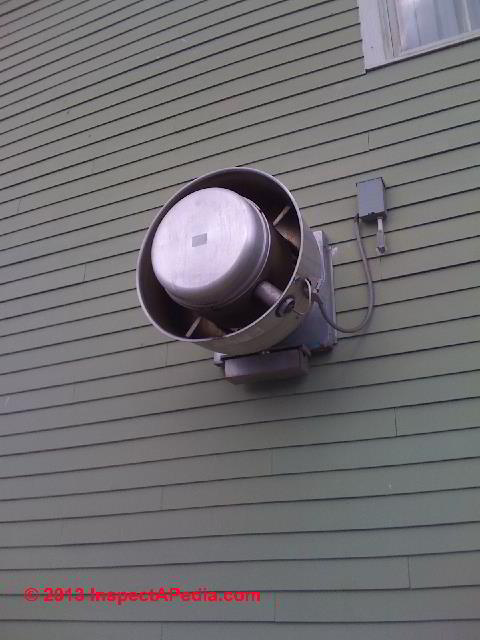
- Baranowski, Richard, Holly Glenn, and John Sivinski. "Biological control of the Caribbean fruit fly (Diptera: Tephritidae)." Florida Entomologist (1993): 245-251.
- CARLSON, DAVID A., and MORTON BEROZA. "Field evaluations of (Z)-9-tricosene, a sex attractant pheromone of the house fly." Environmental Entomology 2, no. 4 (1973): 555-560.
- Carlson, D. A., M. S. Mayer, D. L. Silhacek, J. D. James, Morton Beroza, and B. A. Bierl. "Sex attractant pheromone of the house fly: isolation, identification and synthesis." (1971).
- "Cluster Flies (Pollenia rudis)", Insect Advice from Extension, PennState College of Agricultural Sciences, Department of Entomology, retrieved 7 Nov 2015, original source: http://ento.psu.edu/extension/factsheets/cluster-flies
- Valerie Cervenka & Jeffrey Hahn, "Fall Nuisance Flies", University of Minnesota,
Reviewed 2008, retrieved 11/29/2013, original source http://www1.extension.umn.edu/ garden/insects/find/fall-nuisance-flies/
This article discusses the Cluster fly, Blow fly, Family Calliphoridae, Face fly, Musca autumnalis, Pollenia rudis, and Fall nuisance fly control. - Choo, H. Y., H. W. Kim, D. W. Lee, and Y. D. Park. "Microbial control of fly maggots with entomopathogenic nematodes and fungus in outhouses of farmhouses." Kor J Appl Entomol 35 (1996): 80-84.
- Robert D. Hall and Flernoy G. Jones, "Fly Control in Caged Layer Buildings", Department of Entomology, University of Missouri Extension, (1993) retrieved 11/29/2013, original source: http://extension.missouri.edu/ publications/DisplayPub.aspx?P=G7030
- Malik, Anushree, Neena Singh, and Santosh Satya. "House fly (Musca domestica): a review of control strategies for a challenging pest." Journal of Environmental Science and Health Part B 42, no. 4 (2007): 453-469.
- Miller, Samuel. "FLIES AND FILTH." American Journal of Public Health 4, no. 6 (1914): 512-514.
- Ovruski, Sergio, Martín Aluja, John Sivinski, and Robert Wharton. "Hymenopteran parasitoids on fruit-infesting Tephritidae (Diptera) in Latin America and the southern United States: diversity, distribution, taxonomic status and their use in fruit fly biological control." Integrated Pest Management Reviews 5, no. 2 (2000): 81-107.
- PIMPRIKAR, GAJANAN D., JOHN E. FONDREN, and JAMES R. HEITZ. "Small-and large-scale field tests of erythrosin B for house fly control in caged layer chicken houses." Environmental Entomology 9, no. 1 (1980): 53-58.
- RUTZ, DONALD A., and RICHARD C. AXTELL. "Sustained releases of Muscidifurax raptor (Hymenoptera: Pteromalidae) for house fly (Musca domestica) control in two types of caged-layer poultry houses." Environmental Entomology 8, no. 6 (1979): 1105-1110.
- Sheppard, Craig. "House fly and lesser fly control utilizing the black soldier fly in manure management systems for caged laying hens." Environmental entomology 12, no. 5 (1983): 1439-1442.
- Shute, P. G., and M. Maryon. "? sp. trypanosomes in the semi-digested blood meal of a female Culex pipiens collected in an outhouse in late August 1971. Comparisons between oöcysts of P. vivax and P. berghei as seen in sections of Anopheles stephensi" Transactions of the Royal Society of Tropical Medicine and Hygiene 66, no. 1 (1972): 7.
- Watson, D. W., C. J. Geden, S. J. Long, and D. A. Rutz. "Efficacy of Beauveria bassiana for controlling the house fly and stable fly (Diptera: Muscidae)." Biological Control 5, no. 3 (1995): 405-411.
- Wright, James E. "Insect growth regulators: Laboratory and field evaluations of Thompson-Hayward TH-6040 against the house fly and the stable fly." Journal of economic entomology 67, no. 6 (1974): 746-747.
...
Reader Comments, Questions & Answers About The Article Above
Below you will find questions and answers previously posted on this page at its page bottom reader comment box.
Reader Q&A - also see RECOMMENDED ARTICLES & FAQs
Lots of fly larvae in our outhouse - what's happening?
We have a 12 year old system. It is lightly used. Last year it had a 2” scum layer and 4” solid layer. We stopped putting toilet paper in and a year later we have no scum layer and no solids on the bottom .
When opening the tank lids, one see millions of active larva and almost no offensive odor. What is going on? - On 2019-11-13 by Richard D
This Q&A were posted originally
at SEPTIC SYSTEM INSPECT DIAGNOSE REPAIR
Reply by (mod) - Teeming larvae in a septic tank ? Mosquitoes around the septic tank?
Teeming larvae in a septic tank ?
- Teeming larvae in a septic tank is not a normal condition; Perhaps there's a drain-fly problem? Or more likely a mosquito problem.
- Is there an open vent?
- Is there an open septic tank or septic effluent leaking into the yard?
Also see this information on mosquito problems caused by septic tank openings & leaks:- Septic Systems and Mosquitoes: What You Need to Know [PDF], Marin/Sonoma Mosquito & Vector Control District,
Residents experiencing a mosquito problem can call the Marin/Sonoma Mosquito & Vector Control District for assistance at 1.800.231.3236. Programs and services are supported by property taxes and benefit assessments and are provided at no additional charge. To learn more about mosquito and vector control visit www.msmosquito.com or call 1.800.231.3236.
Original source: https://nextdoor.com/agency-post/ca/marin-county/marinsonoma-mosquito-control-district/septic-systems-and-mosquitoes-what-you-need-to-know-58437744/
Excerpt:
Just one septic tank has the potential to produce hundreds of thousands of mosquitoes per week. These mosquitoes, once dispersed could enter other septic systems in your neighborhood, lay eggs and begin new populations.
This often results in neighborhood-wide mosquito biting problems. The house mosquito is also known to transmit mosquito-borne viruses such as West Nile virus, a potentially life threatening illness.- SEPTIC TANKS and MOSQUITOES [PDF] Marin County Health Department, retrieved 2020/04/04 original source: https://www.marincounty.org/-/media/files/departments/cd/ehs/septic/septictanksandmosquitoesbrochure.pdf
Excerpts: Septic tanks are a common source of mosquito breeding. ... Placing plywood or boards over a tank or man- hole cover will not provide adequate coverage.
The county goes on to recommend installing a septic tank riser at each opening - something that is useful if the septic tank access opening is more than a few inches below the soil level.
Watch out: The Marin County Health Department's advice is dangerously incomplete in speaking about a plywood cover over a septic tank opening. The very first concern is not mosquitoes, it's a quick and nasty death that awaits anybody who falls into a septic tank because the tank's cover is unsafe, unstable, or too-easily removed by a child.
See details at SEPTIC TANK COVERS
and at SEPTIC SYSTEM SAFETY WARNINGS
and see FLIES, MOSQUITOES REMOVE or REPEL around buildings, outhouses, septic systems, where we will re-post your question and our reply.
...
Continue reading a OUTHOUSES & LATRINES - topic home, or select a topic from the closely-related articles below, or see the complete ARTICLE INDEX.
Or see these
Recommended Articles
- ANIMAL ENTRY POINTS in BUILDINGS
- CARPENTER ANTS
- CARPENTER BEES
- FLIES, MOSQUITOES REMOVE or REPEL
- HONEY BEES in BUILDING WALLS
- INSECT DAMAGE PREVENTION
- INSECT DAMAGE - WOOD REPAIR STEPS
- INSECTS & FOAM INSULATION
- INSECT INFESTATION / DAMAGE - home
- LATRINE TYPES & CONSTRUCTION
- MERULIPORIA HOUSE EATING FUNGUS
- MERULIPORIA FUNGUS & TERMITE INTERACTIONS
- PORIA DAMAGE PREVENTION
- OUTHOUSES & LATRINES
- PESTICIDE EXPOSURE HAZARDS
- POWDER POST BEETLES
- SEPTIC TANK COVERS
- TERMITE IDENTIFICATION & CONTROL
- TERMITE SHIELDS vs TERMITICIDE
- WOOD FLOOR, INSECT DAMAGE
- TOILET TYPES, CONTROLS, PARTS
Suggested citation for this web page
FLIES, MOSQUITOES REMOVE or REPEL at InspectApedia.com - online encyclopedia of building & environmental inspection, testing, diagnosis, repair, & problem prevention advice.
Or see this
Ask a Question or Search InspectApedia
Try the search box just below, or if you prefer, post a question or comment in the Comments box below and we will respond promptly.
Search the InspectApedia website
Note: appearance of your Comment below may be delayed: if your comment contains an image, photograph, web link, or text that looks to the software as if it might be a web link, your posting will appear after it has been approved by a moderator. Apologies for the delay.
Only one image can be added per comment but you can post as many comments, and therefore images, as you like.
You will not receive a notification when a response to your question has been posted.
Please bookmark this page to make it easy for you to check back for our response.
IF above you see "Comment Form is loading comments..." then COMMENT BOX - countable.ca / bawkbox.com IS NOT WORKING.
In any case you are welcome to send an email directly to us at InspectApedia.com at editor@inspectApedia.com
We'll reply to you directly. Please help us help you by noting, in your email, the URL of the InspectApedia page where you wanted to comment.
Citations & References
In addition to any citations in the article above, a full list is available on request.
- Baranowski, Richard, Holly Glenn, and John Sivinski. "Biological control of the Caribbean fruit fly (Diptera: Tephritidae)." Florida Entomologist (1993): 245-251.
- CARLSON, DAVID A., and MORTON BEROZA. "Field evaluations of (Z)-9-tricosene, a sex attractant pheromone of the house fly." Environmental Entomology 2, no. 4 (1973): 555-560.
- Carlson, D. A., M. S. Mayer, D. L. Silhacek, J. D. James, Morton Beroza, and B. A. Bierl. "Sex attractant pheromone of the house fly: isolation, identification and synthesis." (1971).
- Choo, H. Y., H. W. Kim, D. W. Lee, and Y. D. Park. "Microbial control of fly maggots with entomopathogenic nematodes and fungus in outhouses of farmhouses." Kor J Appl Entomol 35 (1996): 80-84.
- Robert D. Hall and Flernoy G. Jones, "Fly Control in Caged Layer Buildings", Department of Entomology, University of Missouri Extension, (1993) retrieved 11/29/2013, original source: http://extension.missouri.edu/ publications/DisplayPub.aspx?P=G7030
- Malik, Anushree, Neena Singh, and Santosh Satya. "House fly (Musca domestica): a review of control strategies for a challenging pest." Journal of Environmental Science and Health Part B 42, no. 4 (2007): 453-469.
- Miller, Samuel. "FLIES AND FILTH." American Journal of Public Health 4, no. 6 (1914): 512-514.
- Ovruski, Sergio, Martín Aluja, John Sivinski, and Robert Wharton. "Hymenopteran parasitoids on fruit-infesting Tephritidae (Diptera) in Latin America and the southern United States: diversity, distribution, taxonomic status and their use in fruit fly biological control." Integrated Pest Management Reviews 5, no. 2 (2000): 81-107.
- PIMPRIKAR, GAJANAN D., JOHN E. FONDREN, and JAMES R. HEITZ. "Small-and large-scale field tests of erythrosin B for house fly control in caged layer chicken houses." Environmental Entomology 9, no. 1 (1980): 53-58.
- RUTZ, DONALD A., and RICHARD C. AXTELL. "Sustained releases of Muscidifurax raptor (Hymenoptera: Pteromalidae) for house fly (Musca domestica) control in two types of caged-layer poultry houses." Environmental Entomology 8, no. 6 (1979): 1105-1110.
- Sheppard, Craig. "House fly and lesser fly control utilizing the black soldier fly in manure management systems for caged laying hens." Environmental entomology 12, no. 5 (1983): 1439-1442.
- Shute, P. G., and M. Maryon. "? sp. trypanosomes in the semi-digested blood meal of a female< i> Culex pipiens</i> collected in an outhouse in late August 1971. Comparisons between oöcysts of< i> P. vivax</i> and< i> P. berghei</i> as seen in sections of< i> Anopheles stephensi</i>." Transactions of the Royal Society of Tropical Medicine and Hygiene 66, no. 1 (1972): 7.
- Watson, D. W., C. J. Geden, S. J. Long, and D. A. Rutz. "Efficacy of Beauveria bassiana for controlling the house fly and stable fly (Diptera: Muscidae)." Biological Control 5, no. 3 (1995): 405-411.
- Wright, James E. "Insect growth regulators: Laboratory and field evaluations of Thompson-Hayward TH-6040 against the house fly and the stable fly." Journal of economic entomology 67, no. 6 (1974): 746-747.
- Our recommended books about building & mechanical systems design, inspection, problem diagnosis, and repair, and about indoor environment and IAQ testing, diagnosis, and cleanup are at the InspectAPedia Bookstore. Also see our Book Reviews - InspectAPedia.
- In addition to citations & references found in this article, see the research citations given at the end of the related articles found at our suggested
CONTINUE READING or RECOMMENDED ARTICLES.
- Carson, Dunlop & Associates Ltd., 120 Carlton Street Suite 407, Toronto ON M5A 4K2. Tel: (416) 964-9415 1-800-268-7070 Email: info@carsondunlop.com. Alan Carson is a past president of ASHI, the American Society of Home Inspectors.
Thanks to Alan Carson and Bob Dunlop, for permission for InspectAPedia to use text excerpts from The HOME REFERENCE BOOK - the Encyclopedia of Homes and to use illustrations from The ILLUSTRATED HOME .
Carson Dunlop Associates provides extensive home inspection education and report writing material. In gratitude we provide links to tsome Carson Dunlop Associates products and services.


